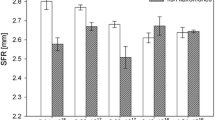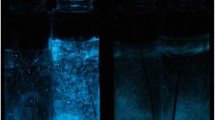Abstract
Using a clone that responds to the presence of fishkairomones by a pronounced change in phototacticbehaviour, we determined how fast a change to morenegatively phototactic behaviour occurs in Daphnia magnaadults that are exposed to a highconcentration of fish kairomones. Kairomone exposedanimals showed an approximately linear decrease in thevalue of the phototactic index with time. Though theresponse was almost immediate, it took two hoursbefore the difference between fish-induced and controlanimals was significant. Extrapolation of the observedresponse indicates that a maximal change inphototactic behaviour, equivalent to animals that havebeen cultured in the presence of fish kairomones sincebirth, occurs after about 13 hours exposure. Weconclude that the predator-induced change in dielvertical migration of zooplankton is fast, and isfully developed in less than a day. The response timeto fish kairomones of Daphnia is shorter forphototactic behaviour than for life history traits,which may have important consequences with respect tothe evolution of trait-dependence in induced defenceresponses.
Similar content being viewed by others
References
Adler, F. R. & C. D. Harvell, 1990. Inducible defenses, phenotypic variability and biotic environments. Trends Ecol. Evol. 5: 407–410.
De Meester, L., 1991. An analysis of the phototactic behaviour of Daphnia magnaclones and their sexual descendants. Hydrobiologia 225: 217–227.
De Meester, L., 1993. Genotype, fish-mediated chemicals and phototaxis in Daphnia. Ecology 74: 1467–1474.
De Meester, L., 1996. Evolutionary potential and local genetic differentiation in a phenotypically plastic trait of a cyclical parthenogen, Daphnia magna. Evolution 50: 1293–1298.
De Meester, L. & J. Pijanowska, 1997. On the trait-specificity of the response of Daphniagenotypes to the chemical presence of a predator. In Lenz, P. H., D. K. Hartline, J. E. Purcell & D. L. Macmillan (eds), Zooplankton: Sensory Ecology and Physiology. Gordon and Breach Publishers, Amsterdam: 407–417.
Forward, R. B. Jr. & D. Rittschof, 1993. Activation of photoresponses of brine shrimp nauplii involved in diel vertical migration by chemical cues from fish. J. Plankton Res. 15: 693–701.
Harvell, C. D., 1990. The ecology and evolution of inducible defenses. Quart. Rev. Biol. 65: 323–340.
Havel, J. E. & S. I. Dodson, 1987. Reproductive costs of Chaoborus-induced polymorphism in Daphnia pulex. Hydrobiologia 150: 273–281.
Larsson, P. & S. Dodson, 1993. Chemical communication in planktonic animals. Arch. Hydrobiol. 129: 129–155.
Lively, C. M., 1986. Competition, comparative life histories, and maintenance of shell dimorphism in a barnacle. Ecology 67: 858–864.
Loose, C. J., 1993. Daphniadiel vertical migration behavior: response to vertebrate predator abundance. Arch. Hydrobiol., Beih. Ergebn. Limnol. 39: 29–36.
Loose, C. J. & P. Dawidowicz, 1994. Trade-offs in diel vertical migration by zooplankton: the costs of predator avoidance. Ecology 75: 2255–2263.
Lüning, J., 1994. Anti-predator defenses in Daphnia–are life-history changes always linked to induced neck spines? Oikos 69: 427–436.
Lynch, M. & R. Ennis, 1983. Resource availability, maternal effects and longevity. Exp. Gerontol. 18: 147–165.
Padilla, D. K. & S. C. Adolph, 1996. Plastic inducible morphologies are not always adaptive: the importance of time delays in a stochastic environment. Evol. Ecol. 10: 105–117.
Parejko, K. & S. I. Dodson, 1990. Progress towards characterization of a predator/prey kairomone: Daphnia pulexand Chaoborus americanus. Hydrobiologia 198: 51–59.
Parejko, K. & S. I. Dodson, 1991. The evolutionary ecology of an antipredator reaction norm: Daphnia pulexand Chaoborus americanus. Evolution 45: 1665–1674.
Reede, T. & J. Ringelberg, 1995. The influence of a fish exudate on two clones of the hybrid Daphnia galeata × hyalina. Hydrobiologia 307: 207–212.
Riessen, H. P., 1984. The other side of cyclomorphosis: why Daphnia lose their helmets. Limnol. Oceanogr. 29: 1123–1127.
Riessen, H. P. & W. G. Sprules, 1990. Demographic costs of antipredator defenses in Daphnia pulex. Ecology 71: 1536–1546.
Ringelberg, J., 1964. The positively phototactic reaction of Daphnia magnaStraus–a contribution to the understanding of diurnal vertical migration. Neth. J. Sea Res. 2: 319–406.
Ringelberg, J. & H. Servaas, 1971. A circadian rhythm in Daphnia magna. Oecologia 6: 289–292.
Ringelberg, J. & E. van Gool, 1995. Migrating Daphniahave a memory for fish kairomones. Mar. Freshwat. Behav. Physiol. 26: 249–257.
Tollrian, R. & E. von Elert, 1994. Enrichment and purification of Chaoboruskairomone from water: further steps toward its chemical characterization. Limnol. Oceanogr. 39: 788–796.
Weider, L. J. & J. Pijanowska, 1993. Plasticity of Daphnialife histories in response to chemical cues from predators. Oikos 67: 385–392.
Author information
Authors and Affiliations
Rights and permissions
About this article
Cite this article
De Meester, L., Cousyn, C. The change in phototactic behaviour of a Daphnia magna clone in the presence of fish kairomones: the effect of exposure time. Hydrobiologia 360, 169–175 (1997). https://doi.org/10.1023/A:1003119827390
Issue Date:
DOI: https://doi.org/10.1023/A:1003119827390




